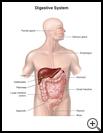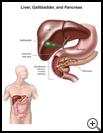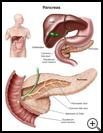
Pancreatitis
What is pancreatitis?
Pancreatitis is swelling and inflammation of the pancreas. The pancreas is an organ behind the stomach. It makes digestive enzymes and insulin. The digestive enzymes flow into the small intestine to help break down food. Insulin is released into the blood to control the level of sugar in the blood.
Pancreatitis can be acute or chronic. Acute pancreatitis is a sudden attack. After acute pancreatitis, most people recover completely, especially if the disease is diagnosed and treated early enough. Pancreatitis that doesn’t go away or keeps coming back and damages the pancreas is called chronic pancreatitis. About half of the people who have pancreatitis have gallstones blocking the flow of pancreatic secretions into the intestines. This causes the pancreas to swell and hurt. Other causes may include drinking alcohol, high levels of blood fats, a viral infection, the side effects of some medicines, some surgeries, smoking, or a serious blunt injury to the belly. It could also be caused by an autoimmune disorder. This means that your body's defenses against infection attack your body's own tissue by mistake.
What can I expect in the hospital?
You may need to stay in the hospital to:
- Control the pain
- Correct the cause of the pancreatitis
- Prevent further damage to your pancreas
Several things may be done while you are in the hospital to monitor, test, and treat your condition. They include:
Monitoring
- You will be checked often by the hospital staff.
- Your heart rate, blood pressure, and temperature will be checked regularly.
- You may have fingersticks to check blood sugar regularly.
- A heart (cardiac) monitor may be used to keep track of your heartbeat.
- Your blood oxygen level may be monitored by a sensor that is attached to your finger or earlobe.
- Your fluid intake may be monitored closely by keeping track of everything you eat and drink and any IV fluids you receive.
- You may have a small tube (catheter) placed into your bladder to drain and measure urine.
Testing
Testing may include:
- Blood tests to check your blood sugar and the levels of enzymes made by the pancreas
- Urine tests to test for chemicals or enzymes made by the pancreas
- Blood, urine, or other tests to monitor how well your organs are functioning
- X-rays: Pictures of the inside of the belly and chest to check for gallstones or other problems
- Ultrasound scan: Sound waves and their echoes are passed through your body from a small device that is held against your skin to create pictures of the inside of the pancreas and gallbladder.
- Computed tomography (CT) scan: A series of X-rays is taken from different angles and arranged by a computer to show thin cross sections of the pancreas and gallbladder.
- Endoscopic retrograde cholangiopancreatography (ERCP): A thin, lighted tube with a camera (called an endoscope) is passed through your mouth and stomach to your pancreas and intestines to look for gallstones, scar tissue, or other problems that may be blocking the passages (ducts) between the pancreas or gallbladder and intestines. If a problem is found, your provider can often treat it during ERCP.
- Magnetic resonance cholangiopancreatography (MRCP): a nuclear medicine study to see if you have gallstones and where they are located
Treatment
The treatment for pancreatitis depends on its cause, your symptoms, how well you respond to treatment, your overall health, and any complications you may have.
- You will have a small tube (IV catheter) inserted into a vein in your hand or arm. This will allow for medicine to be given directly into your blood and to give you fluids, if needed.
- You will need to rest your pancreas by not eating or drinking anything for up to a few days.
- You may have a tube put through your nose down into your stomach, called a nasogastric or NG tube. The tube may be used to give fluids or medicine, or with suction to help relieve pressure from air or fluids in your stomach and intestine.
- You may need a small feeding tube, for prolonged pancreatitis, that allows feeding beyond the pancreas.
- You may need total parenteral nutrition (TPN), which is a mix of protein, sugar, fats, vitamins, electrolytes, and minerals. TPN is given through tubing that is placed into a large vein in the central part of your body called a central line.
- Your provider may prescribe medicines or other therapy to:
- Control your blood sugar
- Replace enzymes that the pancreas normally makes to help digest food
- Treat pain
- Treat or prevent an infection
- Your provider may recommend other types of therapy to help relieve pain, other symptoms, or side effects of treatment.
- You may need surgery to treat pancreatitis. Surgery may include:
- Cholecystectomy: Surgery to remove the gallbladder if gallstones are blocking the duct and causing swelling. This may be done by:
- Open cholecystectomy: Surgery to remove the gallbladder through one larger cut in your upper belly
- Laparoscopic cholecystectomy: Surgery to remove the gallbladder through several small cuts in the upper belly. Your healthcare provider inserts a lighted tube with a camera (called a laparoscope) through the cut and into your belly to help see and remove the gallbladder.
- Percutaneous (through the skin) cholecystostomy tube to drain the gallbladder and provide temporary relief to blocked duct
- Debridement: Surgery to remove part of the pancreas that is infected or dead tissue
- Endoscopic retrograde cholangiopancreatography (ERCP): A slim, lighted tube with a camera (called an endoscope) is passed through the stomach and into the small intestine and bile duct to check for stones, blockages, or other problems. ERCP may be used in combination with:
- Cholelithotomy (gallstone removal): A tiny basket attached to the endoscope is used to remove gallstones that may be blocking the duct.
- Stent placement: A small metal or plastic hollow device is placed through the endoscope into the pancreatic or bile duct and left there to keep the ducts open.
- Balloon dilation: A small balloon attached to the endoscope is inflated to widen the pancreatic or bile duct. This may be done with stent placement.
- Sphincterotomy: Your provider makes one or more small cuts in the muscle (sphincter) that controls the flow of bile and digestive enzymes through pancreatic or bile duct to widen the opening.
- Cholecystectomy: Surgery to remove the gallbladder if gallstones are blocking the duct and causing swelling. This may be done by:
What can I do to help?
- You will need to tell your healthcare team if you have new or worsening:
- Abdominal pain that happens along with:
- Jaw, arm, shoulder, chest, or back pain
- Nausea or vomiting
- Shortness of breath
- Sweating
- Anxiety
- Bowel movement with bright red blood
- Fainting
- Trouble breathing
- Abdominal cramps or pain or bloating
- Black, tarry bowel movements
- Diarrhea, constipation, or other intestinal problems
- Frequent or foul smelling bowel movements
- Redness, swelling, pain, warmth, or drainage from your surgical wound
- Fever, chills, or muscle aches
- Swelling in your legs
- Abdominal pain that happens along with:
- Ask questions about any medicine or treatment or information that you do not understand.
How long will I be in the hospital?
How long you stay in the hospital depends on many things, such as your general health, why you are in the hospital, and the treatment you need. The average amount of time to stay in the hospital with pancreatitis is 4 to 6 days. Talk with your provider about how long your stay may be.
Last modified: 2016-10-11
Last reviewed: 2016-10-11



